Under the Radar – Obi Obi Creek and Tcheergun Walking Tracks
The MVA Walking Track from below Baroon Dam to the Narrows
1989 – 1998
The first MVA record of a proposed walking track to the Obi Obi was in January 1989 when George Johnston reported on the Stage 1 plans of the Landsborough and Maroochy Water Board for recreational areas around the new Baroon Pocket Dam which included such a track. The track was to cross George’s land with his permission. The proposal was supported by Cr. Bob King who allocated funds for plans to be drawn up.
In 1989, George Johnston contacted Major Mark Samios, an engineer in the Australian Army to see if the Engineering Corp could help. It couldn’t, but he referred George to Lieutenant John Flanagan of the Engineering Corp of the New Zealand Army training in Queensland and looking for suitable building projects.
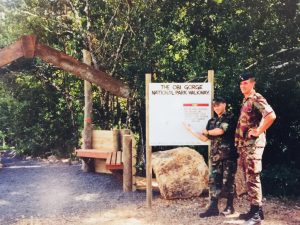
New Zealand Army Engineers at the Entrance to the Walking Tracks
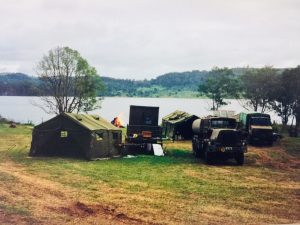
New Zealand Army Engineers Camp on George Johnston’s land above Baroon Dam
Some 30 New Zealand Army engineers camped on George’s land and built the first half of the walk down to the Obi Obi as planned – across George’s land as agreed. The track was finished by Woodford prisoners supervised by the Water Board Ranger and Contractors.
In 1991, Bob Allen sought MVA approval to develop a proposal to extend this track to Kondalilla Falls. George Johnston had already indicated he would be prepared to grant an easement for that section of the track that crossed his land. The MVA supported Bob’s request but noted the disinterest of the National Parks and Wildlife Service.
By 1992, National Parks and Wildlife Service disinterest had firmed into disapproval and local wildlife officer, Peter Shirley, spoke about the disadvantages of such a track and indicated that the service would not be supporting such a proposal across the Kondalilla National Park land.
In 1994, the MVA began discussing building walking tracks to make the most of the recreational opportunities provided by Baroon Dam. It proposed three separate walks:
- A circuit track around Lake Baroon
- A track from Baroon Dam to Kondalilla Falls
- A tree top walk
A small sub-committee was formed; chaired by John Taylor and including Bob Allen and George Johnston.
This group produced a video to promote these ideas. Much of it was shot by a professional cameraman from a helicopter with additional aerial images provided by John Taylor. The video also included still photos, maps and diagrams and was narrated by Bryan McClennan. Armed with this and a sketch of the proposed Tree Top Walk by Rob Vermass, they began discussions with the Caloundra Maroochy Water Supply Board now responsible for Baroon Dam and immediate surrounds.
By 1995, they began talks with the Department of Environment and applied for a Federal Grant to develop their proposal further. The responses that they got were not encouraging.
In mid-1996, they went directly to the Minister for the Environment arguing their case on the concept of Nature Based Tourism being promoted by his department. By August, they were advised that the Baroon Dam to Kondalilla Falls walk was one of two projects under consideration for funding. They were not successful. Part of the problem appeared to be the reluctance of Parks and Wildlife to allow them access through the Kondalilla National Park.
In March, 1997, they were advised that they could possibly proceed with Stage 1 that did not enter the national park but crossed land owned by the Water Board (previously George Johnston’s) and Maroochy Shire Council from below the dam for approximately 800metres. They had only lost 200metres of their initial plan but this meant they could not have a lookout over the Narrows as the track’s destination. Instead, they planned a ‘bird watching’ platform over a gully at the end of the 800 metres.
They immediately met with Water Board and Council to present their case. In June, the Water Board gave permission for the track to cross its land. In July, Council also came on board. Alex Somlyay MP became a strong advocate for the project and suggested that the Work for the Dole Scheme may fit it and they agreed to investigate this. Bryan McClennan was approached and agreed to survey the track on a pro bono basis.
At the August, 1997 AGM of the MVA, Judy Pippin and Bob Allen were able to report that they had lodged an application for a Work for the Dole project with three distinct parts: Renovation and Maintenance Work on the Montville Village Hall and St. Mary’s Hall; Theatre Productions and The Walking Track.
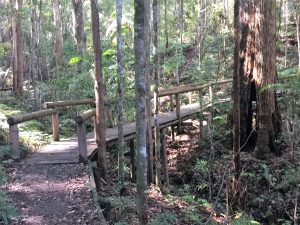
Bridge built by Sid Johnston and Work for the Dole Team on behalf of the Montville Village Association
This application proved successful and 24 young people joined the scheme in February, 1998. Eight of these chose to work on the Walking Track Project under the supervision/mentorship of Bob Allen, John Watkins and Jeremy Henderson with Master Builder, Sid Johnston overseering the bridge building; Jim Watson from Barung the revegetation and Master Potter and Ceramic Teacher, Trevor Spohr, assisted by Josie Jonker and Work for the Dole members, Lara Stone and Leanne Hanley creating and installing a tiled mosaic in the bird-watching platform at the end of the walk.
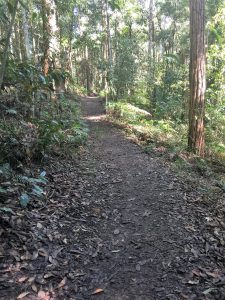
Tcheergun (Blackbutt Tree) Track
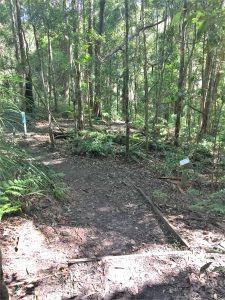
The Obi Obi Creek Walk
The work on the track commenced. At the start, some of the Work for the Dole participants were not very enthusiastic but attitudes changed once progress could be seen. Progress was good but funds ran out in June before the final stage including the bird watching platform with the ceramic tile feature could be undertaken. Lead by a Caloundra City Council donation of $2,500, local sponsorship raised a further $625 to fund this stage. All up, community contributions to the project totaled $5,797.24 including $1,790 from the Water Board and $535.56 from Maroochy Shire Council. Local Sponsors included Tree Top Cabins on the Lake (now Secrets on the Lake); The Narrows Escape; Ferme Auberge (now The Spotted Chook); Montville Misty View; Montville Provencal and Barung Landcare. Along with Alex Somlyay’s patronage, all these are acknowledged on the tiled mosaic centre piece at the end of the walk. The track was completed at a cost of $14,168.48 and opened by Alex Somlyay in July, 1998.
Naturally, locals made their own track across the 200 metres of national park to the Narrows and eventually National parks and Wildlife did extend the path and built the Narrows Lookout and the Baroon Lookout over the Obi Obi Gorge. Then in 2004, the powerful Public Works Committee prepared a report (no 86) on The Great Walks of Queensland Project. Without any meaningful local input, this committee proposed The Sunshine Coast Hinterland Great Walk of 45 kilometres from Baroon Pocket to Mapleton Forest Reserve (Page 8). The walk was to feature natural wildlife, historical indigenous sites and European cultural history. The Great walk was developed and opened up some incredible landscapes but neither Indigenous cultural heritage nor European cultural heritage seems to have been incorporated into it. The fact that the walk incorporated existing walks at the Baroon Pocket end was never acknowledged and the earlier signs identifying the tracks and who made them were removed. Three large National Parks and Wildlife Signs at the entrance of the park replaced the original signage placed by the New Zealand Engineers, with one of these including a brief sentence recognizing the importance of the Bunya Feasts in Baroon Pocket to local Aboriginal people. Further down the track past the entrance is a SEQ Water sign identifying its contribution in creating the Obi Obi Creek Track and the Tcheergun* Track but not who actually built these. *Tcheergun is the Kabi Kabi word for the Blackbutt Tree.
The state of the two earlier walking tracks incorporated in the Great walk, the Obi Obi Creek Track and the Tcheergun Track, is generally good for tracks that are now over 20 years old.
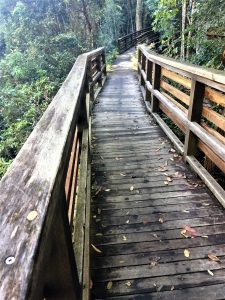
New Zealand Engineers, Bridge
Some subsequent repairs to sleepers and bridges is evident but otherwise most of these tracks are what were constructed in 1990 and 1998. Unfortunately, the tiled mosaic centerpiece in the bird watching platform at the end of the MVA track has lifted, several pieces of the circular border stolen and one central tile broken.
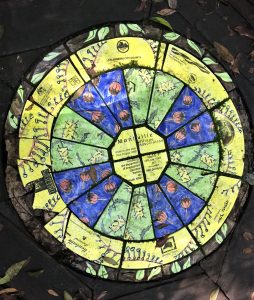
Tiles recognising supporting businesses and associations
It seems that it has been in this state for some time now and needs to be repaired and refixed before any further deterioration occurs. Of far greater concern is the failure of the Parks and Wildlife Service, who now administers these walks it once vehemently objected to, as part of the Great Walk, has failed to implement the cultural recognition that was to be featured in the Great Walk. There is little recognition of the significance of Baroon Pocket and the Obi Obi Creek to Aboriginal Cultural Heritage and, as a result, no matching “Welcome to Country” greeting. Nor is there any acknowledgement of the vision and effort of a small group of dedicated members of the MVA who persevered to achieve their vision but finally failed to overcome bureaucratic enforcement of dated policy.
It is time that the National Parks and Wildlife Service honoured its charter to recognise those who came before it in Baroon Pocket and the Obi Obi Gorge. A chance meeting with SEQ Water Rangers has revealed that SEQ Water has accepted responsibility for the maintenance of the Obi Obi Track and the Tcheergun Track and although these are in quite good condition no attempt has been made to date to restore the ceramic tiled centre piece that is an important part of pre-Great Walk history.
Doug Patterson
Montville History Group
Sources:
MVA Minutes 1989 to 1998
Happenings Vol 5 No 1, 2000
Public Works Committee, Report 86: The Great Walks of Queensland Project, September 2004
Interview Notes – George Johnston and Bob Allen
Copies of Letters by GP and AL Johnston, 1988 to 1992
Physical Inspection of Tracks, 13/06/2019
SEQ Water
Sunshine Coast Council

 ©2016 Montville History Group. All rights reserved.
©2016 Montville History Group. All rights reserved.